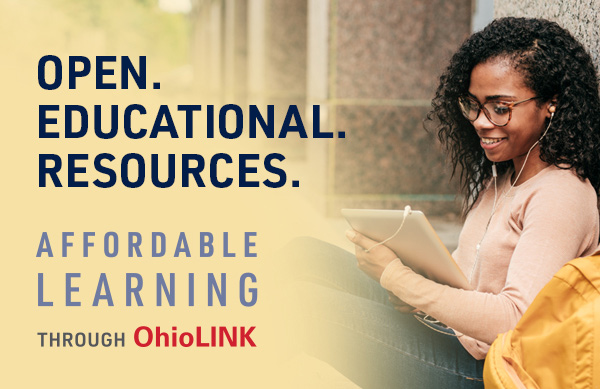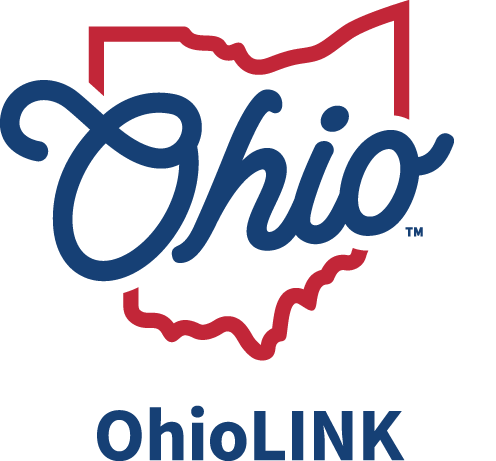What is OhioLINK?
OhioLINK, part of the Ohio Department of Higher Education, is Ohio’s academic library consortium. Easy, fast access to a vast amount of scholarly material has made Ohio’s higher ed library system the envy of academics across the country and OhioLINK one of the most respected library consortia.
If you are looking for an article or book, chances are that you can get it through OhioLINK. OhioLINK cost-effectively acquires and maintains shared electronic library resources for its members--more than 37 million digital journal articles, more than 241,000 electronic books, and more than 100 databases. It also funds and manages Ohio’s inter-library loan program from a shared catalog of 38 million books and printed items.
OhioLINK has negotiated five read and publish agreements for its institutions’ authors. These publishing agreements allow authors to publish open access at no cost to the authors or additional cost to their institutions, in addition to providing access to a broad range of high-quality research articles from these publishers. Please see OhioLINK's open access publishing for authors page for additional information. Your institution’s library would be happy to provide more information about what is available to you.
What is OhioLINK's Springer open access agreement?
In addition to OhioLINK member institutions' current access to Springer journal titles through the Electronic Journal Center (EJC), OhioLINK has negotiated an upgraded agreement that offers access to over 700 additional electronic journals from Springer Nature along with open access publishing benefits.
Starting in January 2024, authors at most OhioLINK member institutions will have the ability to publish open access (OA) journal articles in eligible hybrid journals published by Springer Nature (including many Springer, Palgrave, Adis, and academic journals at nature.com) at no additional cost to either the author or the institution. Nature portfolio journals such as Nature itself and Scientific American are not included. Fully open access journals are not included.
With this agreement, there is a maximum number of articles that may be published open access across all OhioLINK institutions. Once the limit is reached, the option to publish articles open access at no cost under the agreement will no longer be available. Authors may choose to publish behind the subscription paywall or to pay the APC for open access on their own.
What is Open Access? What does hybrid mean?
Open Access (OA) is a way to publish that makes content freely available with no subscription or access fees. Journal publishers were traditionally compensated for the editorial and distribution work of providing scholarly articles through journal subscription fees. In order to make articles open, publishers are compensated for their editorial and publishing services through an Article Publication Charge (APC), which varies by journal. OhioLINK's agreement with Springer gives member authors and institutions the option to publish open access in eligible journals without paying any APC. Open access publication often also includes licensing the work to allow for reuse, such as the use of Creative Commons licenses (see more information about licenses on Springer's website).
OhioLINK's open access deal with Springer applies only to articles published in eligible hybrid journals. "Hybrid" means that the journal publishes articles that are available both by subscription and through open access. Fully open access journal titles accept only articles that will be published as open access. For more information about open access, see Springer's fundamentals of open access page.
Who is eligible to publish open access under this agreement?
In order to be eligible to publish open access at no cost in a Springer journal under this agreement, the corresponding author of the article (see below for definition) must be affiliated with an institution that subscribes to OhioLINK’s Electronic Journal Center (EJC), a full text searchable database of electronic journal articles from top scholarly publishers.
There is a maximum number of articles across all OhioLINK institutions that may be published as open access. Should this limit be reached, authors will no longer see the option to request their article be published as open access at no charge under this deal. When that happens, authors can choose to publish as open access and pay the Article Publication Charge (APC), or choose to publish as a traditional subscription-access only article. See information about APCs for hybrid journals in the Hybrid Journals section on Springer's Open Access Journals Page.
What is a corresponding author? How is their affiliation identified?
The corresponding author is the person who agrees to handle the manuscript and correspondence during the publication process. Providing Springer with the name of your OhioLINK-affiliated institution and an institutional email address is part of the process for confirming institution affiliation. (Use of an institutional email address is encouraged to ensure the corresponding author’s eligibility can be accurately determined.) Each article is reviewed to verify eligibility.
When can I publish open access articles in Springer hybrid journals?
To publish an article as open access in an eligible Springer journal without paying any Article Publication Charge (APC), the request for coverage of the APC must be approved between January 1, 2024 and December 31, 2026. Corresponding authors are presented with the option to request to publish their article as open access under this agreement following acceptance for publication by the journal.
What kind of articles are eligible for open access publishing under this agreement? Which journals are eligible?
The following article types are eligible for the hybrid open access publishing benefits (see FAQ above for additional information on timing):
- Original Paper – Standard article, generally presenting new results which may also be referred to as Original Research, Original Article, Original Paper or Research Paper.
- Review Paper – Standard article, interpreting previously published results.
- Brief Communication – Short article submitted for rapid publication that exhibits the same structure as a standard article.
- Continuing Education – Article forming integral part of further education (usually medical).
There are over 2,000 eligible hybrid journals from Springer, Adis, Palgrave and academic journals at nature.com. Nature portfolio journals such as Nature itself and Scientific American are not included. Fully open access journals are not included. For the most up-to-date list, check the Excel list of eligible hybrid journals, also available on Springer's website for the OhioLINK agreement.
How does an author choose to publish an article as open access?
Corresponding authors affiliated with an eligible institution who are publishing an eligible article type in an eligible journal are offered the option to publish their article as open access under the agreement. (See FAQs below for details.)
When a corresponding author's article has been approved for publication in an eligible Springer journal, they are offered the option to publish their article as open access. In order to be offered the option of publishing open access at no charge, the annual cap limit must not have been reached.
Is there a limit to how many articles can be published as open access under this agreement?
There is an annual limit to the number of articles to be published as open access under this agreement across all of OhioLINK member institutions, based on historical publishing trends. Should the article limit be reached, authors will no longer see the option to request to publish their article as open access under this agreement. Authors could then choose to publish open access by paying the APC or they also could choose to publish their article as a traditional subscription-access only article at no cost to them. See Springer's Open Access webpage for information about list price APCs.
When the limit is reached, OA publishing fees for affiliated authors at these institutions can no longer be waived for the remainder of the calendar year with Springer. Authors from these institutions may choose to publish open access by paying the APC or they also could choose to publish their article as a traditional subscription-access only article at no cost to them. Starting January 1, coverage for OA publishing fees will again be available with a new annual allowance for OA articles.
For information about other open access agreements through OhioLINK, view the OA for authors page. Your institution’s library can also help with questions.
What information and training are available for faculty and authors?
Springer offers additional resources for authors interested in publishing their articles open access on their web site:
- See participating institutions, eligible journals, and more on Springer's webpage for the OhioLINK agreement with information for authors.
- Learn more about the fundamentals of Open Access at Springer.
- Find answers to frequently-asked questions at Springer's support page for authors on publishing open access
- View the recording of the Springer Author Workshop for OhioLINK February 12, 2024.
OhioLINK will also create resources for this and other open access agreements it offers:
- The OhioLINK’s Open Access Agreements Summary Table answers open access publishing FAQ for the agreements available through OhioLINK.
Where can I go with questions?
Your librarians are the best resource to answer questions about hybrid open access publishing with Springer. Find your library's contact information here.
Springer has a dedicated email address for OA questions: oa.verification@springernature.com. They also have customer service support able to help with authors' open access questions -- scroll down to Support for Authors.
For more information about open access publishing opportunities available through OhioLINK, see OhioLINK's web page about open access publishing for authors.
Updated January 31, 2025

